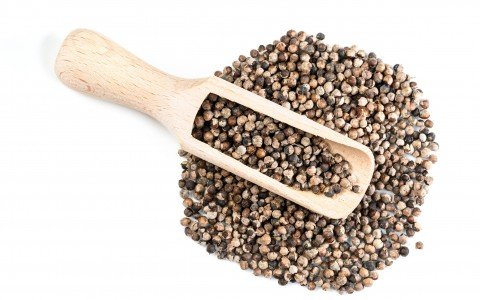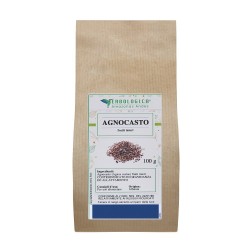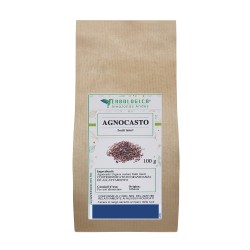
L'agnocasto, noto anche come vitex o pepe di monaco, è un piccolo frutto viola che è stato usato per secoli per trattare una varietà di disturbi della salute.
Questo frutto unico è stato usato nella medicina tradizionale per migliaia di anni e ora sta diventando sempre più popolare negli ambienti della salute naturale.
L'agnocasto ha un'ampia gamma di potenziali benefici per la salute, tra cui la capacità di ridurre le infiammazioni, migliorare la salute riproduttiva e persino ridurre i sintomi della menopausa.
Può anche essere usato come rimedio naturale per la sindrome premestruale e altri problemi mestruali.
In questo articolo esploreremo i molti usi e benefici dell'agnocasto e perché sta diventando una parte importante dei regimi di salute naturale di molte persone.
Usi e benefici dell'agnocasto
L'agnocasto, noto anche come vitex o pepe di monaco, è un piccolo frutto viola che è stato usato per secoli per trattare una varietà di disturbi della salute.
Questo frutto unico è stato usato nella medicina tradizionale per migliaia di anni e ora sta diventando sempre più popolare negli ambienti della salute naturale.
L'agnocasto ha un'ampia gamma di potenziali benefici per la salute, tra cui la capacità di ridurre le infiammazioni, migliorare la salute riproduttiva e persino ridurre i sintomi della menopausa.
Può anche essere usato come rimedio naturale per la sindrome premestruale e altri problemi mestruali.
In questo articolo esploreremo i numerosi usi e benefici dell'agnocasto e il motivo per cui sta diventando una parte importante dei regimi di salute naturale di molte persone.
Introduzione al frutto dell'agnocasto
L'agnocasto è un piccolo frutto viola che proviene dall'albero dell'agnocasto, originario della regione mediterranea.
Il frutto ha le dimensioni di un pisello e ha un sapore dolce e di nocciola.
L'albero dell'agnocasto è stato usato per secoli nella medicina tradizionale, ma solo di recente è diventato popolare nei moderni circoli di salute naturale.
L'agnocasto ha un'ampia gamma di potenziali benefici per la salute, tra cui la capacità di ridurre l'infiammazione, migliorare la salute riproduttiva e persino ridurre i sintomi della menopausa.
Può anche essere usato per trattare la sindrome premestruale e altri problemi mestruali.
L'agnocasto è un modo efficace e naturale per migliorare la salute generale.
Storia dell'agnocasto
L'agnocasto è utilizzato nella medicina tradizionale da migliaia di anni. Nell'antica Grecia, l'agnocasto veniva usato per trattare problemi ginecologici e come afrodisiaco.
Nel Medioevo si pensava che aiutasse a controllare il desiderio sessuale e che fosse usato dai monaci per rimanere casti.
Veniva anche usato per trattare i problemi mestruali e si credeva che aiutasse a promuovere la fertilità.
In tempi moderni, l'agnocasto è diventato sempre più popolare negli ambienti della salute naturale.
Viene utilizzato per trattare un'ampia gamma di problemi di salute, dalla sindrome premestruale alla menopausa.
Sta diventando sempre più accettato come alternativa alla medicina tradizionale.
Benefici dell'agnocasto per la salute
L'agnocasto ha un'ampia gamma di potenziali benefici per la salute.
È noto per ridurre l'infiammazione, migliorare la salute riproduttiva, ridurre i sintomi della menopausa e trattare la sindrome premestruale e altri problemi mestruali.
Si ritiene inoltre che aiuti a bilanciare gli ormoni e a stimolare la fertilità.
L'agnocasto è noto per ridurre l'infiammazione dell'organismo.
Alcuni studi hanno dimostrato che può ridurre l'infiammazione del tratto digestivo e quella delle articolazioni e dei muscoli.
Può anche contribuire a ridurre il dolore e la rigidità associati all'artrite e ad altre condizioni infiammatorie.
Si ritiene che l'agnocasto contribuisca anche a migliorare la salute riproduttiva.
È noto che aiuta a bilanciare gli ormoni, a migliorare la fertilità e a ridurre i sintomi della sindrome premestruale e della menopausa.
Si ritiene inoltre che aiuti a regolare il ciclo mestruale, a ridurre i crampi mestruali e a ridurre il rischio di aborto.
L'agnocasto può essere utilizzato anche per ridurre i sintomi della menopausa.
È noto che aiuta a ridurre le vampate di calore, la sudorazione notturna e altri sintomi della menopausa.
Può anche contribuire a migliorare l'umore e a ridurre l'ansia e la depressione.
Diversi usi dell'agnocasto
L'agnocasto può essere utilizzato in diversi modi per migliorare la salute generale.
Può essere assunto sotto forma di capsule o tintura, oppure aggiunto a tè, frullati e altre ricette.
Può anche essere applicato topicamente come olio essenziale o lozione.
L'agnocasto è disponibile anche sotto forma di integratore.
Gli integratori sono solitamente a base di agnocasto essiccato e in polvere, il che li rende più facili da assumere e più convenienti rispetto ad altre forme.
Come usare l'agnocasto
L'agnocasto può essere assunto sotto forma di capsule o tintura, oppure può essere aggiunto a tè, frullati e altre ricette.
È disponibile anche sotto forma di integratore. Quando si assume l'agnocasto, è importante seguire le indicazioni riportate sull'etichetta, poiché forme e dosaggi diversi possono avere effetti diversi.
L'agnocasto può anche essere applicato per via topica come olio essenziale o lozione.
Quando si utilizzano oli essenziali, è importante diluirli con un olio vettore, come l'olio di cocco o di jojoba, per ridurre il rischio di irritazione della pelle.
Possibili effetti collaterali dell'Agnocasto
Sebbene l'agnocasto sia generalmente considerato sicuro, esistono alcuni possibili effetti collaterali.
Questi includono mal di testa, nausea e vertigini.
È anche possibile che si verifichino irritazioni cutanee quando si utilizzano oli essenziali.
È importante parlare con il proprio medico prima di assumere l'agnocasto, soprattutto in caso di gravidanza o allattamento.
Non ci sono ricerche sufficienti per stabilire se l'agnocasto sia sicuro per queste popolazioni.
È inoltre importante notare che l'agnocasto può interagire con alcuni farmaci, quindi è importante parlarne con il proprio medico prima di assumerlo.
Consigli per l'assunzione di Agnocasto
Quando si assume l'agnocasto, è importante seguire le indicazioni riportate sull'etichetta.
Forme e dosaggi diversi possono avere effetti diversi, quindi è importante assumere il dosaggio consigliato.
È inoltre importante parlare con il proprio medico prima di assumere l'agnocasto, soprattutto in caso di gravidanza o allattamento.
Non ci sono ricerche sufficienti per stabilire se l'agnocasto sia sicuro per queste popolazioni.
L'agnocasto può anche interagire con alcuni farmaci, quindi è importante parlarne con il medico prima di assumerlo.
Ricette con l'agnocasto
L'agnocasto può essere aggiunto a tè, frullati e altre ricette.
Ha un sapore dolce e di noce che si sposa bene con altri ingredienti.
Ecco alcune ricette che utilizzano l'agnocasto:
-Frullato di agnocasto: Frullate insieme 1 tazza di latte di mandorla, 1 banana, 1 cucchiaio di polvere di agnocasto e 1 cucchiaino di miele per un frullato delizioso e nutriente.
-Tè all'agnocasto: Mettete in infusione 1 cucchiaino di polvere di agnocasto in 1 tazza di acqua calda per 5 minuti. Aggiungere miele e limone a piacere.
-Insalata di agnocasto: Unire in una ciotola 1 tazza di spinaci, 1/2 tazza di pomodori a cubetti, 1/2 tazza di cetrioli a cubetti e 1 cucchiaio di polvere di agnocasto. Irrorare con olio d'oliva e succo di limone e condire con sale e pepe.
Integratori di agnocasto
L'agnocasto è disponibile anche sotto forma di integratore.
Gli integratori sono solitamente a base di agnocasto essiccato e in polvere, il che li rende più facili da assumere e più convenienti rispetto ad altre forme.
Quando si sceglie un integratore, è importante cercarne uno a base di ingredienti biologici e di alta qualità.
È inoltre importante seguire le indicazioni riportate sull'etichetta e parlare con il proprio medico prima di assumere qualsiasi integratore.
Conclusioni
L'agnocasto è un piccolo frutto viola utilizzato da secoli nella medicina tradizionale.
Ha un'ampia gamma di potenziali benefici per la salute, tra cui la capacità di ridurre l'infiammazione, migliorare la salute riproduttiva e persino ridurre i sintomi della menopausa.
Può anche essere usato come rimedio naturale per la sindrome premestruale e altri problemi mestruali.
L'agnocasto può essere assunto sotto forma di capsule o tintura, aggiunto alle ricette o applicato topicamente come olio essenziale o lozione.
È importante parlare con il proprio medico prima di assumere l'agnocasto, poiché può interagire con alcuni farmaci.
L'agnocasto è un modo efficace e naturale per migliorare la salute generale.



